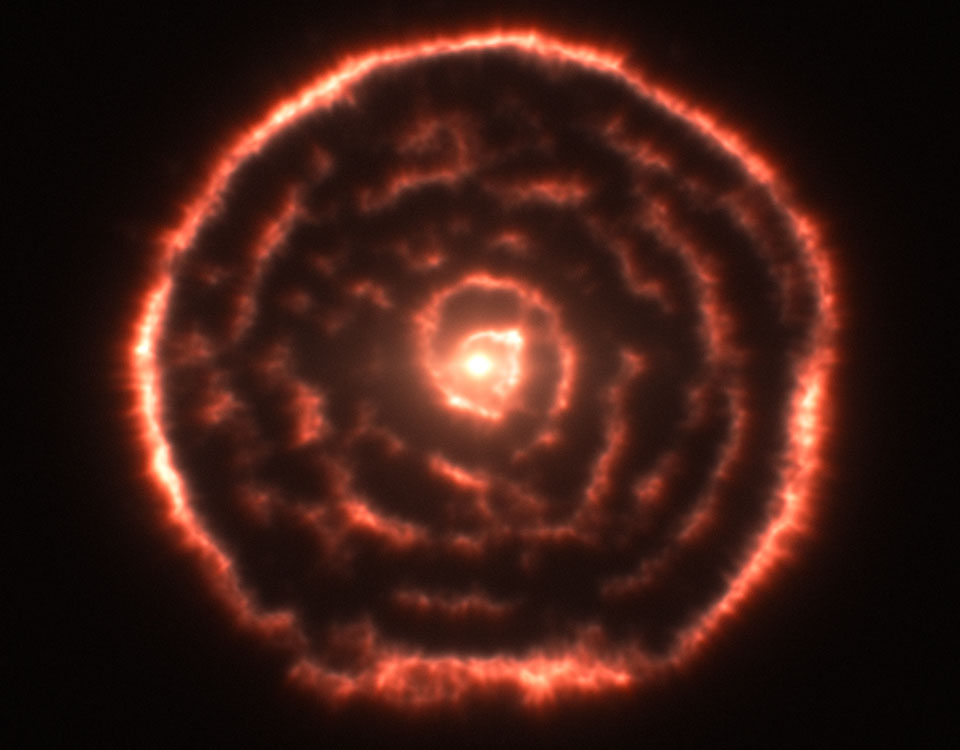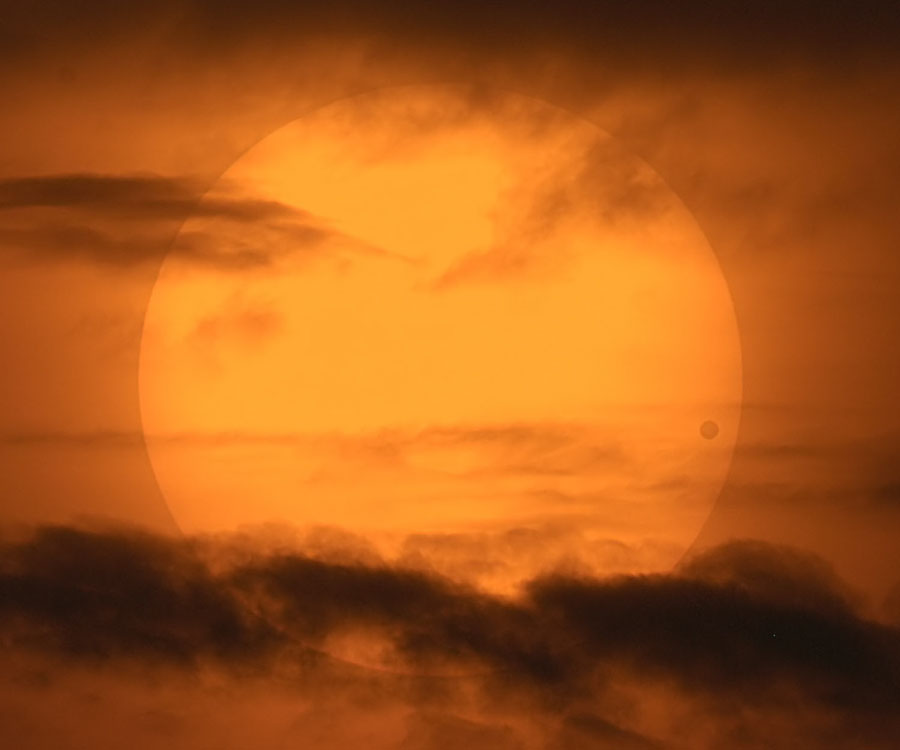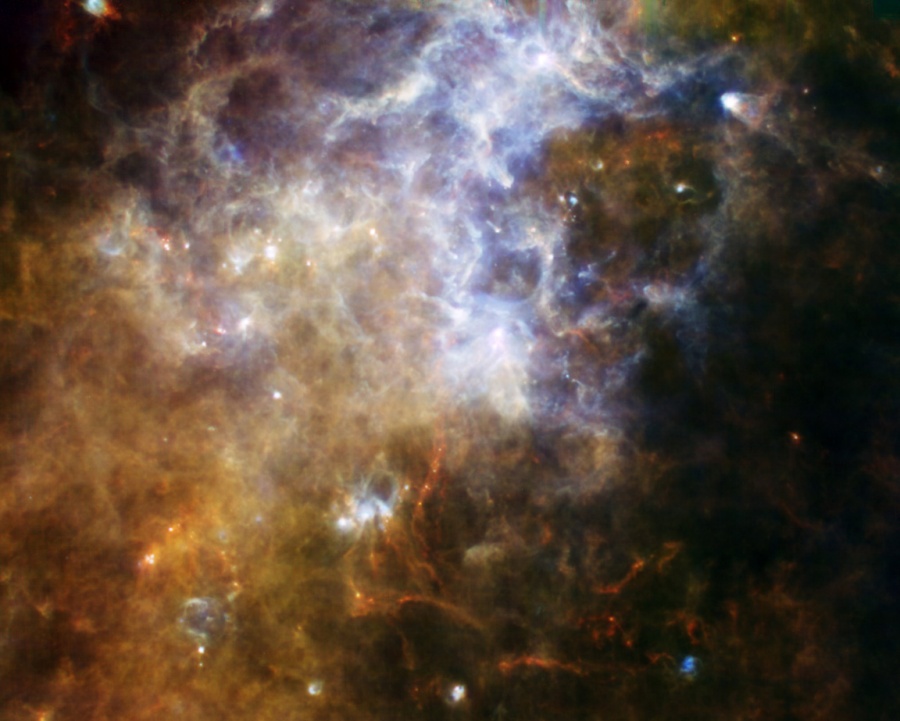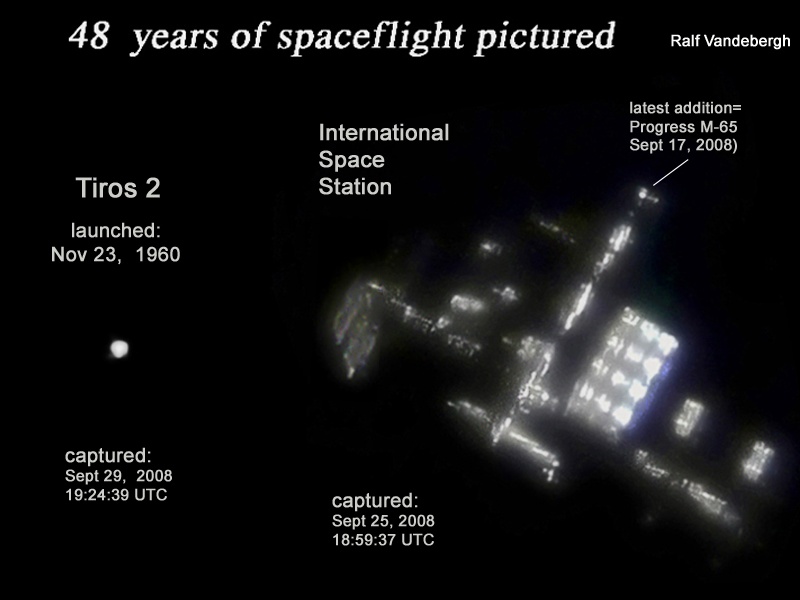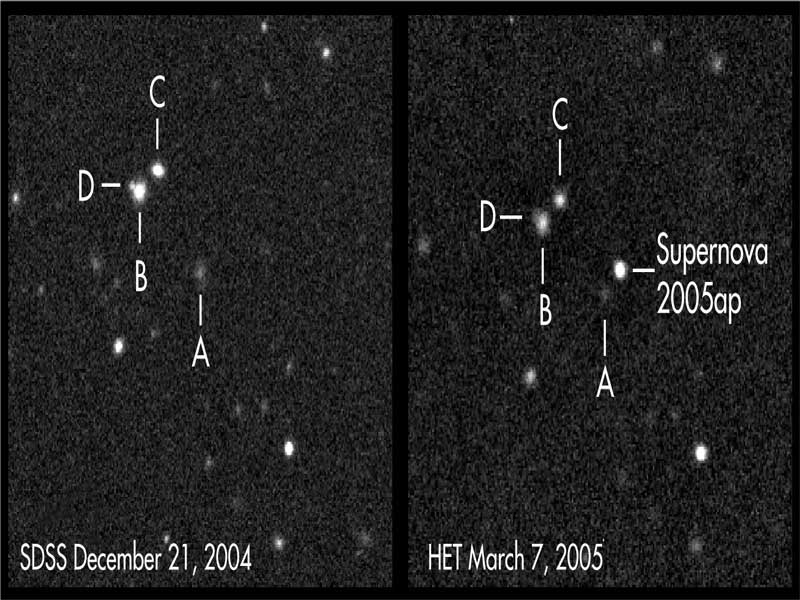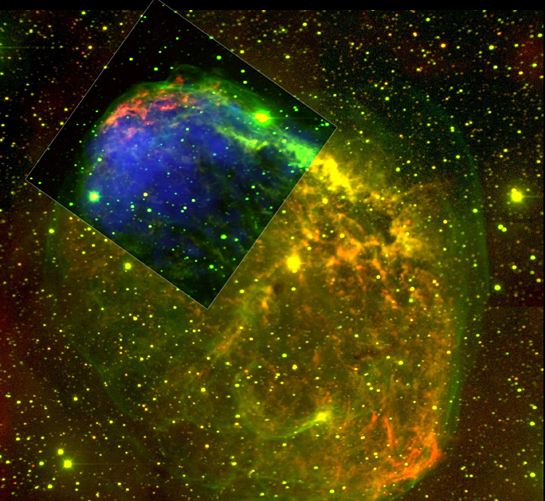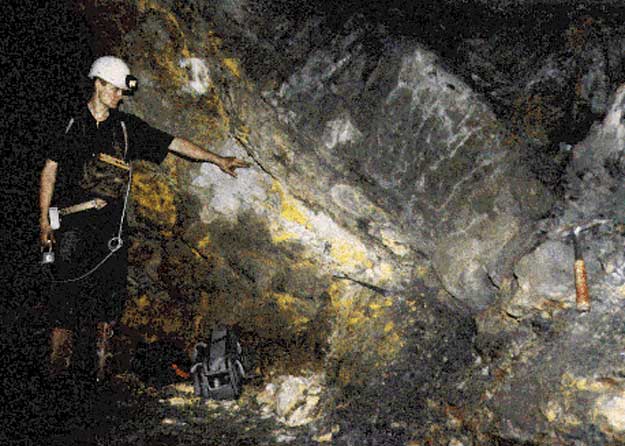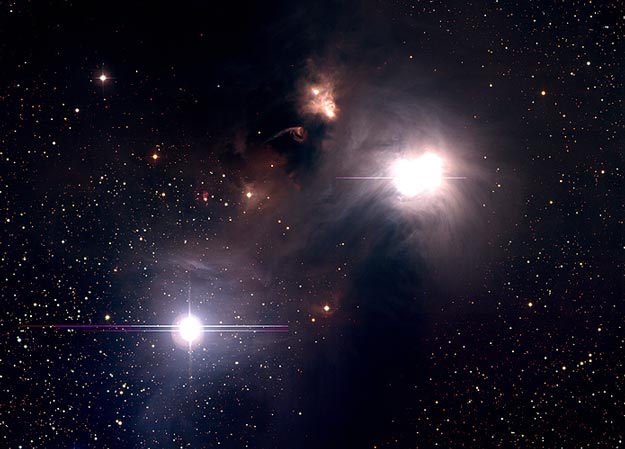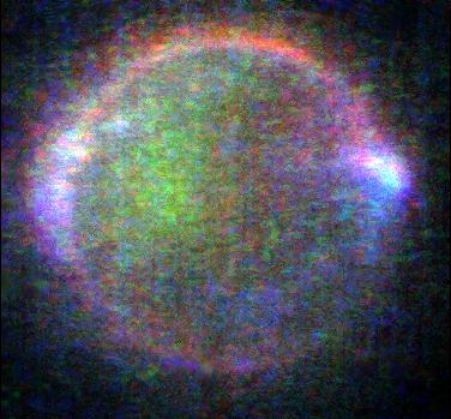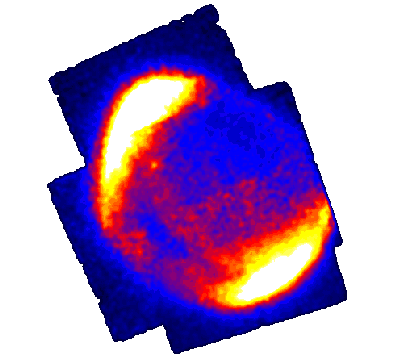| << Previous | Index | Next >> |
2014 This Rosetta spacecraft selfie was snapped on October 7th. At the time the spacecraft was about 472 million kilometers from planet Earth, but only 16 kilometers from the surface of comet 67P/Churyumov-Gerasimenko. Looming beyond the spacecraft near the top of the frame, dust and gas stream away from the comet's curious double-lobed nucleus and bright sunlight glints off one of Rosetta's 14 meter long solar arrays. In fact, two exposures, one short and one long, were combined to record the dramatic high contrast scene using the CIVA camera system on Rosetta's still-attached Philae lander. Its chosen primary landing site is visible on the smaller lobe of the nucleus. This is the last image anticipated from Philae's cameras before the lander separates from Rosetta on November 12. Shortly after separation Philae will take another image looking back toward the orbiter, and begin its descent to the nucleus of the comet.
2013 This intriguing trio of galaxies is sometimes called the Draco Group, located in the northern constellation of (you guessed it) Draco. From left to right are edge-on spiral NGC 5981, elliptical galaxy NGC 5982, and face-on spiral NGC 5985 -- all within this single telescopic field of view spanning a little more than half the width of the full moon. While the group is far too small to be a galaxy cluster and has not been catalogued as a compact group, these galaxies all do lie roughly 100 million light-years from planet Earth. On close examination with spectrographs, the bright core of the striking face-on spiral NGC 5985 shows prominent emission in specific wavelengths of light, prompting astronomers to classify it as a Seyfert, a type of active galaxy. Not as well known as other tight groupings of galaxies, the contrast in visual appearance makes this triplet an attractive subject for astrophotographers. This impressively deep exposure hints at faint, sharp-edged shells surrounding elliptical NGC 5982, evidence of past galactic mergers. It also reveals many even more distant background galaxies.
2012 What's happening around that star? An unusual spiral structure has been discovered around the Milky Way star R Sculptoris, a red giant star located about 1,500 light years away toward the constellation of the Sculptor (Sculptoris). The star was observed with the new Atacama Large Millimeter/submillimeter Array (ALMA), the most powerful telescopic array observing near millimeter wavelengths, that part of the spectrum situated well beyond red light but before microwaves and radio waves. Data from ALMA observations was used to create a 3D visualization of the gas and dust immediately surrounding the star. A digital slice through this data showed the unexpected spiral structure. Although unusual, a similar spiral pattern was discovered in visible light recently around LL Pegasi. Upon analyzing the data, a hypothesis was drawn that the red giant star in R Sculptoris might be puffing gas toward an unseen binary companion star. The dynamics of this system might be particularly insightful because it may be giving clues as to how giant stars evolve toward the end of their lives -- and so release some constituent elements back to the interstellar medium so that new stars may form.
2011 The rare transit of Venus across the face of the Sun in 2004 was one of the better-photographed events in sky history. Both scientific and artistic images flooded in from the areas that could see the transit: Europe and much of Asia, Africa, and North America. Scientifically, solar photographers confirmed that the black drop effect is really better related to the viewing clarity of the camera or telescope than the atmosphere of Venus. Artistically, images might be divided into several categories. One type captures the transit in front of a highly detailed Sun. Another category captures a double coincidence such as both Venus and an airplane simultaneously silhouetted, or Venus and the International Space Station in low Earth orbit. A third image type involves a fortuitous arrangement of interesting looking clouds, as shown by example in the above image taken from North Carolina, USA. The next transit of Venus across the Sun will be in 2012 June.
2010 The 16th century Portuguese navigator Ferdinand Magellan and his crew had plenty of time to study the southern sky during the first circumnavigation of planet Earth. As a result, two fuzzy cloud-like objects easily visible to southern hemisphere skygazers are known as the Clouds of Magellan, now understood to be satellite galaxies of our much larger, spiral Milky Way galaxy. About 160,000 light-years distant in the constellation Dorado, the Large Magellanic Cloud (LMC) is seen here in a remarkably deep, colorful composite image, starlight from the central bluish bar contrasting with the telltale reddish glow of ionized atomic hydrogen gas. Spanning about 15,000 light-years or so, it is the most massive of the Milky Way's satellite galaxies and is the home of the closest supernova in modern times, SN 1987A. The prominent patch at top left is 30 Doradus, also known as the magnificent Tarantula Nebula. The giant star-forming region is about 1,000 light-years across.
2009 With a 3.5 meter diameter mirror, larger than the Hubble Space Telescope, Herschel is ESA's new infrared observatory. The space-based telescope is named for German-born British astronomer Frederick William Herschel who discovered infrared light over 200 years ago. In initial tests, Herschel's cameras have combined to deliver this spectacular view along the plane of the Milky Way in the constellation of the Southern Cross. Spanning some 2 degrees the premier, false-color, far-infrared view captures our galaxy's cold dust clouds in extreme detail, showing a remarkable, connected maze of filaments and star-forming regions. These and planned future Herschel observations are intended to unravel mysteries of star formation by surveying broad areas of the galactic plane.
2008 This year, NASA celebrated its 50th anniversary. Inspired to make his own contribution, astronomer Ralf Vandebergh set out to record images of some historic spacecraft in Earth orbit -- captured with his own modest equipment and a hand-guided, 10-inch, Newtonian reflecting telescope. One result is this intriguing composite effectively spanning 48 years of space flight! From a 1960 launch, on the left is the TIROS 2 satellite, one of the first successful weather satellites. While this TIROS (Television InfraRed Observation System) satellite stopped functioning in 1961, Vandebergh notes that if we could visit it now, we would still find video cameras and magnetic tape recorders. On the right, of course, is the ISS (International Space Station) including its recent addition, the Progress M-65 cargo vehicle, launched to the ISS just last month.
2007 What could cause a bang this big? This supernova explosion was so inherently bright that it could be seen nearly 5 billion light years away (a redshift of 0.28) even with a small telescope. Specific colors emitted during SN 2005ap indicate that it was a Type II supernova, a breed of stellar explosion that results when a high mass star begins fusing heavy elements in or near its core. Type II supernovas may be more powerful than their Type Ia cousins, but they are not currently more useful cosmologically because astronomers don't understand how to accurately recover their intrinsic brightnesses. It is therefore dimmer Type Ia supernovas that are used by astronomers to calibrate the distance scale of the nearby universe. Were Type II supernova better understood, astronomers might be able to probe distances further into the universe, and so probe the stability of the strange dark energy that dominates the present universe. Pictured above in a digitally compressed image, the bright supernova SN 2005ap is visible on the right where no exploding star had been seen on the left less than three months before.
2006 In the shadow of Saturn, unexpected wonders appear. The robotic Cassini spacecraft now orbiting Saturn recently drifted in giant planet's shadow for about 12 hours and looked back toward the eclipsed Sun. Cassini saw a view unlike any other. First, the night side of Saturn is seen to be partly lit by light reflected from its own majestic ring system. Next, the rings themselves appear dark when silhouetted against Saturn, but quite bright when viewed away from Saturn and slightly scattering sunlight, in the above exaggerated color image. Saturn's rings light up so much that new rings were discovered, although they are hard to see in the above image. Visible in spectacular detail, however, is Saturn's E ring, the ring created by the newly discovered ice-fountains of the moon Enceladus, and the outermost ring visible above. Far in the distance, visible on the image left just above the bright main rings, is the almost ignorable pale blue dot of Earth.
2005 Demonstrating her mastery of a traditional astronomical imaging technique quilter and astronomy enthusiast Judy Ross has produced this spectacular composition of "Astronomy Quilt Piece of the Week". Her year-long effort resulted in an arrangement for a six by seven foot quilt consisting of 52 individual pieces (11 inches by 8 inches), one for each week, which she reports were inspired by her steady diet of APOD's daily offerings. Some of the pieces are based on actual pictures, such as the Hubble Space Telescope's view of planet forming AB Aurigae or Bill Keel's image of the nearby Pinwheel Galaxy. Others, with titles like the Blue Carpet Nebula and Duck Contemplates Black Hole, are from her own creative imaginings.
2004 Edge-on spiral galaxy NGC 3079 is a mere 50 million light-years away toward the constellation Ursa Major. Shown in this stunning false-color Hubble Space Telescope image, the galaxy's disk - composed of spectacular star clusters in winding spiral arms and dramatic dark lanes of dust - spans some 70,000 light-years. Still, NGC 3079's most eye-catching features are the pillars of gas which tower above a swirling cosmic cauldron of activity at the galaxy's center. Seen in the close-up inset at lower right, the pillars rise to a height of about 2,000 light-years and seem to lie on the surface of an immense bubble rising from the galactic core. Measurements indicate that the gaseous pillars are streaming away from the core at 6 million kilometers per hour. What makes this galaxy's cauldron bubble? Astronomers are exploring the possibility that the superbubble is formed by winds from massive stars. If so, these massive stars were likely born all at once as the galactic center underwent a sudden burst of star formation.
2003 NGC 6888, also known as the Crescent Nebula, is a cosmic bubble of interstellar gas about 25 light-years across. Created by winds from the bright, massive star seen near the center of this composite image, the shocked filaments of gas glowing at optical wavelengths are represented in green and yellowish hues. X-ray image data from a portion of the nebula viewed by the Chandra Observatory is overlaid in blue. Such isolated stellar wind bubbles are not usually seen to produce energetic x-rays, which require heating gas to a million degrees celsius. Still, NGC 6888 seems to have accomplished this as slow moving winds from the central star's initial transition to a red supergiant were overtaken and rammed by faster winds driven by the intense radiation from the star's exposed inner layers. Burning fuel at a prodigious rate and near the end of its stellar life, NGC 6888's central star should ultimately go out with a bang, creating a supernova explosion in 100,000 years or so. NGC 6888 is about 5,000 light-years close, toward the constellation Cygnus.
2002 The remnants of nuclear reactors nearly two billion years old were found in the 1970s in Africa. These reactors are thought to have occurred naturally. No natural reactors exist today, as the relative density of fissile uranium has now decayed below that needed for a sustainable reaction. Pictured above is Fossil Reactor 15, located in Oklo, Gabon. Uranium oxide remains are visible as the yellowish rock. Oklo by-products are being used today to probe the stability of the fundamental constants over cosmological time-scales and to develop more effective means for disposing of human-manufactured nuclear waste.
2001 Would a volcano plume discovered in January above Jupiter's Moon Io still be active months later? To answer this question, the robot spacecraft Galileo currently in orbit around Jupiter was maneuvered to image the plume site during its recent flyby of Io in August. What was found was the highest volcano plume yet discovered -- but above a completely different and previously undocumented volcano! The original plume, above the Tvashtar Catena volcanic area, was not even visible. A picture taken in January of the area surrounding the Tvashtar Catena eruption is shown above in enhanced color, with a new picture taken in August shown in the inset. Careful inspection of the two images will show a newly prominent dark volcano surrounded by a light-colored ring visible only in the smaller, more recent image.
2000 Young star R Coronae Australis has a dusty home. The dust is so thick on the upper left of the above photograph that little light from background stars comes through. Thinner dust near the stars reflects light from R Coronae Australis (upper right) and neighbor TY Coronae Australis, giving their surroundings a flowing appearance. Were these stars more massive they would emit light energetic enough to ionize much of the nearly invisible surrounding hydrogen gas, causing it to appear bright red. The unusual structure above the center is a Herbig-Haro object, a knot of gas ejected from the star that has impacted surrounding gas. R Coronae Australis is about 500 light-years away, while the region shown is about four light years across.
1999 "Do not look at stars as bright spots only - try to take in the vastness of the universe." On October 1, 1847 Maria Mitchell swept the sky with her telescope and discovered a comet (comet Mitchell 1847VI). Honored and recognized internationally for her discovery, Mitchell, who lived from 1818 to 1889, became one of the most famous American scientists of her day. Vassar College appointed Mitchell the first woman Professor of Astronomy and she remained the only woman ever elected to the American Academy of Arts and Sciences until 1943. Mitchell mentored a generation of scientists, and is fondly remembered for her ability to motivate. "We especially need imagination in science," Maria Mitchell said, "Question everything."
1998 Alluring aurora surrounding Io (eye-oh) appear as a ghostly glow while the volcanic moon orbits within Jupiter's dark shadow. Gas giant Jupiter is off to the right of this image, recorded in May by the robot Galileo spacecraft's solid state imaging camera from a distance of about 1.3 million kilometers. Energetic charged particles colliding with Io's atmospheric gases create the vivid colors and produce the red and green glow analogous to the aurora of Earth. The striking blue light is caused by dense volcanic plumes and may indicate regions electrically connected to Jupiter itself.
1997 NASA's Saturn Explorer Cassini with ESA's Titan Probe Huygens attached successfully rocketed into the skies early yesterday morning. The mighty Titan 4B Centaur rocket is seen here across the water gracefully arcing away from Launch Complex 40 at Cape Canaveral Air Station. Cassini, a sophisticated, bus-sized robot spacecraft is now on its way ... to Venus, the first planetary way point in its 7 year, 2.2 billion mile journey to Saturn. The mission profile calls for Cassini to swing by Venus during April 1998 and June 1999, Earth in August 1999, and Jupiter in December 2000. During each of these "gravity assist" encounters the six ton spacecraft will pick up energy needed to reach Saturn in July 2004. Cassini's mission is the most ambitious voyage of interplanetary exploration ever mounted by humanity and the Huygens Probe's planned descent to the surface of Titan will be the most distant landing ever attempted.
1996 Research balloon flights conducted in 1912 by Austrian physicist Victor Hess revealed that the Earth was constantly bombarded by high energy radiation from space - which came to be called "Cosmic Rays". What are Cosmic Rays and where do they come from? They are now known to be mostly subatomic particles - predominantly protons and electrons - but their origin is a long standing mystery. After almost a century of study, this cosmic puzzle may have been at least partially solved by new X-ray images and spectra from the ASCA satellite observatory. Pieced together to show the region around a star observed to go supernova in 1006 AD, the overlapping X-ray snapshots above (seen in false color) reveal the bright rims of the exploded star's still expanding blast wave. These ASCA observations show for the first time that the energy spectrum of the bright regions is like that produced by extremely high energy electrons streaming through a magnetic field at nearly the speed of light. If (as expected) high energy protons are associated with these energetic electrons then supernova remnants like SN 1006 are sources of Hess' puzzling Cosmic Rays.
1995 The spiral galaxy M94 is somewhat unusual in that it shows a great ring of bright young stars particularly apparent when observed in ultraviolet light, as shown above. Such a high abundance of these young blue stars may cause a galaxy to be designated a starburst galaxy. It is likely that many of the stars seen in the above ring were created when a density wave moving in the galaxy compressed existing galactic gas. The above picture was taken by the Ultraviolet Imaging Telescope during the Astro-2 mission in March 1995.
| << Previous | Index | Next >> |


